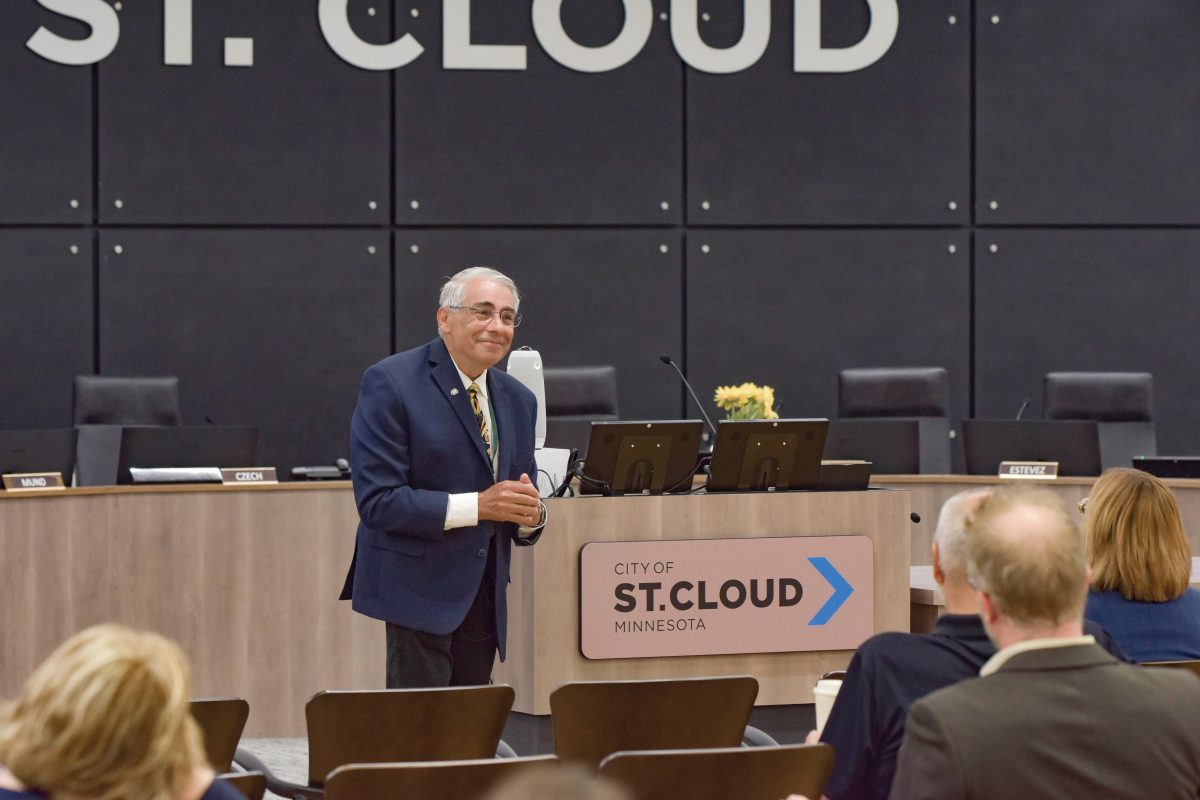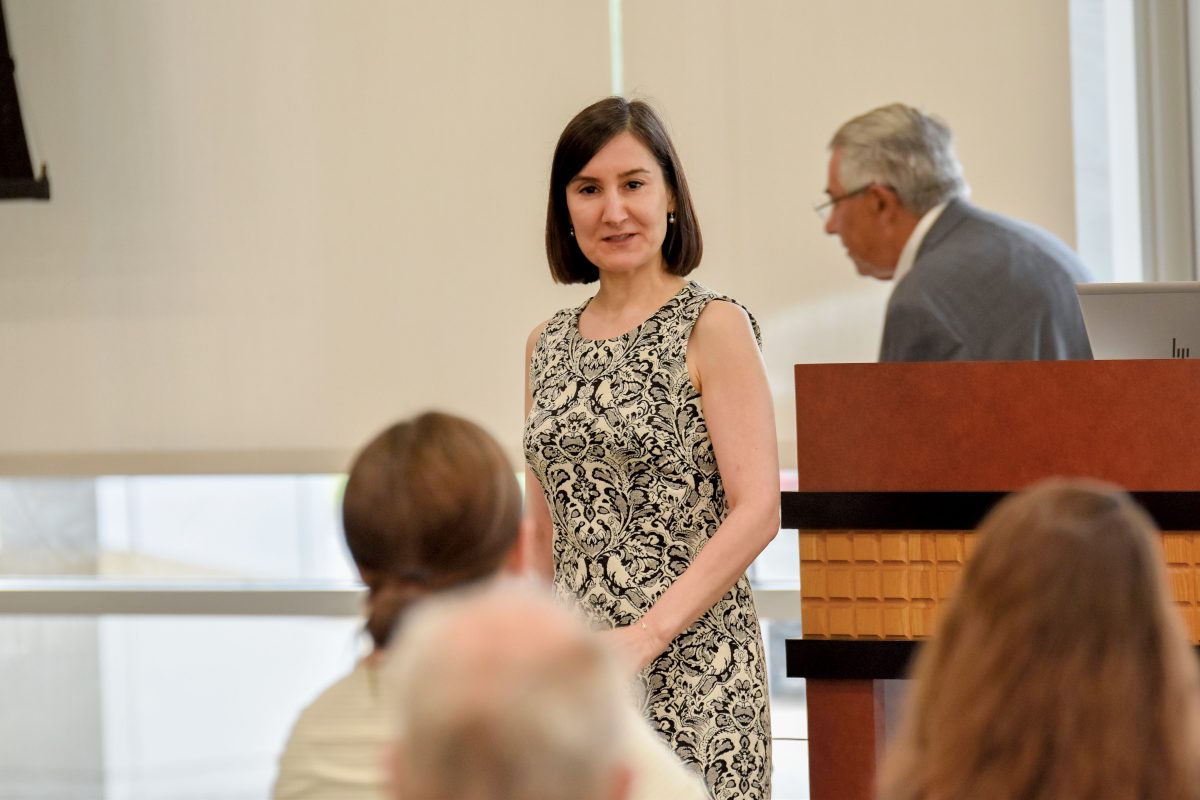
King Banaian and his fellow St. Cloud State University economists have been making sense of ups and downs in the local business climate for a quarter of a century via their much-anticipated St. Cloud Area Quarterly Business Report (QBR).
As translators of academic, economic and complex business data, Banaian and his partners in the QBRs have a reputation for being accessible, credible experts tapped by the media and the public for helping them sort out how current economic circumstances will impact their bottom line.
Banaian is the Dean of the School of Public Affairs at SCSU. He said his predecessor, former Dean Orn Bodvarrson, put it well when he called the School of Public Affairs’ world-class research that benefits students and community partners “the window in the door through which the community sees SCSU.”
“Forecasting is not what we economists do best, but it’s what the audience wants to hear,” Banaian said. “The old joke is that God put economists on the earth to make meteorologists feel better.”
As an example of how quickly economic circumstances can change, the QBR of 2022, which came out in December, stated: “We predict the St. Cloud metro area will be in recession within the next four to six months, based on results of the St. Cloud Area Quarterly Business Survey as well as data on professional employment and the stock prices of area publicly-traded corporations.”
But fast forward three months and Banaian and his current partner in producing the QBRs, Economics Professor Mana Komai Molle, are predicting a better scenario, that the “sort of predicted” recession may not happen. “We may have dodged the real crash landing,” Molle said. “It looks like St. Cloud is in a good place.”
While the pulse of the local economy or any economy may be unpredictable and subject to unforeseen occurrences, the reports are welcome and highly respected. Their contents are based on information gathered through a prudent system that begins with timely, carefully crafted questions put to regional business leaders, and the results of their responses are shared along with a careful analysis of leading economic indicators.
All this data is gathered and condensed every three months into a concise report welcomed by regional business and government leaders as well as local folks at their kitchen tables.
The local recession probability index was added as a permanent feature of the report in October 2007, when the deteriorating circumstances of the global recession of 2007-2009 made the public sit up and take greater notice of economic news and the information Banaian and the QBRs were sharing.

Recently retired Economics Professor Rich MacDonald, who with former Professor Mark Partridge started working on a local business report that became the QBR in 1998, welcomed Banaian as the partner who would do data analysis and presentation for the report. “King’s data skills are better than anybody I know, and he’s made a big difference.”
“As a colleague, I always have looked up to King,” Molle said. “He’s done so much for the community.”
Local business and community leaders value the QBRs and the insights they bring. “Through the passionate leadership of King Banaian and over the course of nearly 25 years, our community has had the benefit of economic research, data analysis and a survey of business leaders to help inform and provide local insight into our local economy,” said Patti Gartland, president of the Greater St. Cloud Development Corporation, a graduate of St. Cloud State and a member of the SCSU School of Public Affairs Advisory Board.
The QBRs include a significant number of quotes throughout from leaders of the business community who answer questions and offer insight into what’s happening to them personally and delving deeper into topics of interest to businesses, households and governments. “I think those responses still are one of the best parts of the reports,” Banaian said.
“King and his team then translate the research, analysis and survey responses into an easy-to-consume publication, the St. Cloud Area Quarterly Business Report, and give an oral presentation that showcases key takeaways, insights, and predictions,” said Gartland. “QBR provides the finger on the pulse of our local economy. We are so fortunate to have such expertise and commitment to community vitality in our own backyard.”
For years that expertise was shared through a partnership with Times Media, which every three months had a front-page news story heralding the latest findings and inserted the full Quarterly Business Report into the back pages. When the pandemic hit and the paper no longer had the staff or budget to include the report, Banaian and his partners quickly transitioned to sharing the information online and through community presentations.
“The impact is that we’ve probably doubled the audience,” Banaian said.
The entire archive of current and past reports can be found in the SCSU Repository, which houses a treasure trove of research assembled over the years by faculty and students.
Molle, who joined Banaian on the QBRs after MacDonald decided to retire, said she is enjoying the work on policy issues and macroeconomics. “It’s inspired me to care more about the community,” she said.
“The way I teach my classes has changed,” Molle said of her involvement with QBRs. “I have good examples for my students, and they seem to be more interested because of the connections to what’s happening around them. It’s not just some model. It’s more personal.”
Banaian is proud of the impact the work with the QBRs has had on the academic side of his work. “It’s a teaching tool, the mechanics of which help students learn about forecasting.
“It makes us unusual,” he added. “Less than 20 percent of business schools across the country have this tool to show how economics can really make an impact by looking at basic data and looking at it in a systematic way.”
